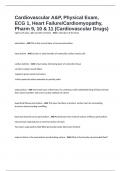Cardiovascular A&P, Physical Exam,
ECG 1, Heart Failure/Cardiomyopathy,
Pharm 9, 10 & 11 (Cardiovascular Drugs)
right & left atria, right and left ventricles - ANS 4 chambers of the heart
epicardium - ANS This is the visceral layer of serous pericardium
myocardium - ANS circular or spiral bundles of contractile cardiac muscle cells
cardiac skeleton - ANS crisscrossing, interlacing layer of connective tissue
-Anchors cardiac muscle fibers
-Supports great vessels and valves
-Limits spread of action potentials to specific paths
endocardium - ANS innermost layer of the heart; it's continuous with endothelial lining of blood vessels
(lines heart chambers and covers cardiac skeleton of valves)
Superficial fibrous pericardium - ANS This layer functions to protect, anchor heart to surrounding
structure and preventing overfilling.
Deep two-layered serous pericardium - ANS Parietal layer lines internal surface of fibrous pericardium
Visceral layer (epicardium) on external surface of heart
Two layers separated by fluid-filled pericardial cavity (decreases friction)
reduce friction in the pericardium by lubricating surface - ANS What is the function of pericardial fluid?
,diastole - ANS the ventricles relax & fill with blood from atria
aortic & pulmonic valves close (S2)
mitral & tricuspid valves open - ANS During diastole what valves close and what valves open?
mitral and tricuspid valves close (S1)
aortic and pulmonic valves open - ANS During systole what valves close and what valves open?
isovolumetric contraction - ANS refers to the short period during ventricular systole when the ventricles
are completely closed chambers
isotonic contraction - ANS A phase during ventricular systole where there's blood ejection
atrial systole - ANS Atria contracts and blood gets pumped into ventricles
ventricular systole - ANS Ventricular contraction as blood pumps out to body.
Atrial Diastole - ANS atria relaxes and fills with blood
ventricular diastole - ANS ventricles relax and fill with blood
tricuspid valve - ANS valve between the right atrium and the right ventricle
pulmonary valve - ANS valve positioned between the right ventricle and the pulmonary artery
bicuspid valve (mitral) - ANS valve between left atrium and left ventricle
,aortic valve - ANS heart valve between the left ventricle and the aorta
SVC to right atrium, tricuspid, right ventricle, pulmonary artery, lungs, pulmonary vein, left atrium,
bicuspid (mitral), left ventricle, aortic valve, aorta then to body and back to the SVC. - ANS adult path of
blood flow
Blood exits right ventricle, pulmonary artery, pulmonary trunk, right & left pulmonary arteries,
arterioles, capillary beds in lungs, CO2 released, oxygen absorbed, capillary beds, venules, pulmonary
veins, left atrium. - ANS pulmonary circuit
SVC, right atrium, foramen ovale, left atrium, left ventricle, aorta, heart muscle, brain, arms, SVC, right
atrium, right ventricle, pulmonary artery, lungs (small amount), ductus arteriosus (most of the blood
through here), descending aorta, umbilical arteries, placenta, CO2 & waste products released, oxygen &
nutrients, umbilical vein, ductus venosus, IVC, right atrium. - ANS Fetal circulation
stroke volume (SV =EDV-ESV or CO = HR x SV) - ANS the amount of blood ejected during systole is called
what?
SA node, AV node, AV bundle (Bundle of His), Bundle branches, Purkinje Fibers - ANS Trace the path of
electrical current in the heart
P wave - ANS Atrial depolarization initiated by SA node causing what on an ECG?
PR segment - ANS Wave of depolarization spreads completely throughout the atria and conduction is
delayed at the AV node causing what on ECG?
QRS complex - ANS Atrial repolarization occurs as ventricular depolarization begins causing what on an
ECG?
, ST segment - ANS Ventricular depolarization is completed causing what on an ECG?
T wave - ANS Ventricular repolarization spreads from apex of the heart, which produces what on an ecg?
TP interval - ANS Ventricular repolarization completed is shown as what on an ECG?
arteries, veins, capillaries - ANS three types of circulatory blood vessels in body
tunica adventitia, tunica media, tunica intima - ANS What are the three tissue layers of arteries and
veins?
tunica adventitia - ANS This is the outer layer of arteries and veins, but it's the heaviest wall layer for
veins
tunica media - ANS This is the middle layer of tissue for arteries and veins, but this layer is the thickest
for arteries
tunica intima - ANS This is the innermost layer of arteries and veins, however, the veins have a one-way
valve
arteriole - ANS small arteries that deliver blood to capillaries
capillaries - ANS smallest and most numerous of blood vessels, form connection between the vessels
that carry blood away from the heart and the vessels that return blood to the heart. Function is for the
exchange of materials between the blood and tissue cells.
venule - ANS a. smallest of the veins that connect capillaries to veins. They collect the blood from the
capillaries and drain into the veins.




